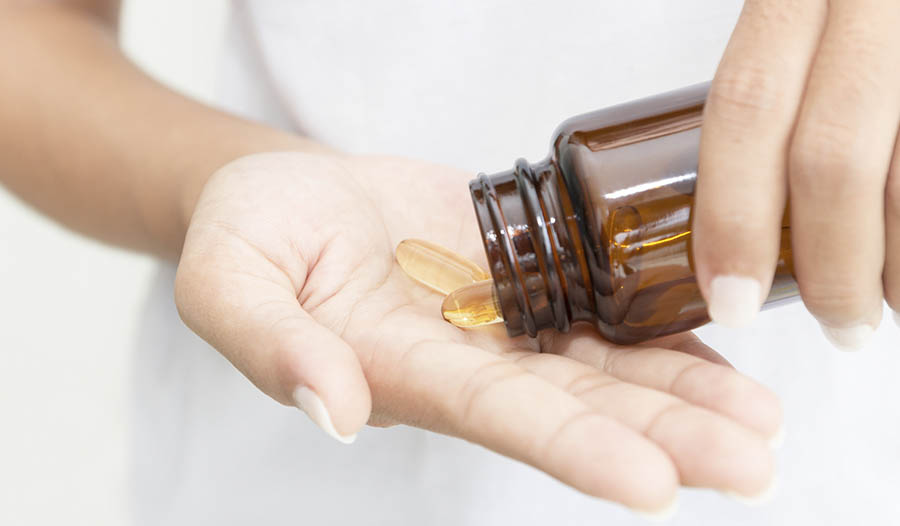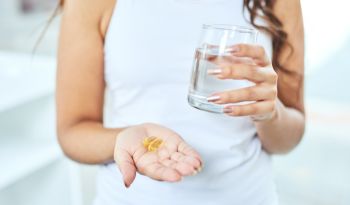Top 10 Supplements for Women’s Health

Women have unique nutritional needs that must be taken into account to optimize health. Below is a list of the top supplements a woman should evaluate and consider, based on where she is in her life’s journey and what concerns she may be facing.
- Multivitamin
- Vitamin D
- Iron
- Vitamin C
- Magnesium
- Omega 3
- Calcium
- Collagen
- Black cohosh
- Evening primrose
Multivitamin
A multivitamin should be taken by each and every woman. While a well-balanced diet is crucial to optimal health, our daily stressors can add additional metabolic demands on our body that may not always be fulfilled by diet alone. Chronic disease also affects our nutrient requirements along with popular blood pressure, acid-reducing, and diabetic prescription drugs, which can also deplete the body of important vitamins and minerals.
What does the American Medical Association, the leading medical organization in the world, say about vitamins? They say they should be taken! On June 19, 2002, a study in the Journal of the American Medical Association made the following recommendation: “We recommend that all adults take one multivitamin daily…”
A quality multivitamin provides extra assurance that the body is getting what it needs. If extra nutrients are present, the body will store what it needs and eliminate the additional. For women who are still having periods, a multivitamin with iron may be considered. For those women who no longer have menstrual periods, a multivitamin without iron is usually taken.
Ensuring your multivitamin has iodine in it is also important as studies show that more than 10 percent of women worldwide may be deficient in this vital nutrient. Women in the United States are also at risk, contrary to popular belief. A 2011 study in Thyroid demonstrated that almost 10 percent of people in the United States had moderate to severe iodine deficiency, and at least an additional five percent are mildly deficient.
Suggested dose: As directed on the label
Vitamin D
Thousands of studies over the last decade show health benefits when one optimizes vitamin D intake. These studies tell us that those with higher levels of vitamin D in their blood have a lower risk of heart attacks, breast cancer, colon cancer, ovarian cancer, multiple sclerosis and other health complications.
In my Southern California medical practice, a place where we have sunny skies more than 300 days per year, four in five of my patients have had a clinical vitamin D deficiency.
The reason for this common deficiency is that few people spend the required 15 to 20 minutes each day in the sunlight, allowing their face, arms and legs to be exposed to the ultraviolet light. Up to 90 percent of people around the world are deficient. Those with more melanin, which is responsible for skin pigmentation, require up to 30 minutes in the sun per day to generate adequate vitamin D. Those over age 65 years also require more time outdoors to generate vitamin D due to reduced skin elasticity.
Lower levels of vitamin D in the blood have been associated with increased risk for the following conditions:
- Breast cancer
- Ovarian cancer
- Pancreatic cancer
- Fibromyalgia
- Falls and fractures
- Multiple sclerosis
- Autoimmune conditions
- High blood pressure
- Heart attacks and strokes
Suggested dose: Adults 1,000 IU to 5,000 IU daily. Children, 1,000 IU to 2,000 IU of vitamin D. Read about more about the health benefits of vitamin D. Take under the supervision of your doctor.
Iron
During a woman's menstrual cycle, anywhere from 30 ml (one ounce) to 500 ml (around one pint) of blood, which includes iron, can be lost due to bleeding. Unless a woman has hemochromatosis or another disorder in which excessive iron is absorbed, iron supplementation is frequently recommended by a doctor.
A common cause of anemia, or low blood hemoglobin, is iron deficiency. When a person does not have enough iron stored in her body, she is unable to make red blood cells, which transport oxygen throughout the body. When anemia is present, a person may have shortness of breath, feel chronically tired, appear pale, have brittle nails and even have restless legs syndrome.
Suggested dose: As directed on the label or by your physician
Vitamin C
Vitamin C, or ascorbic acid, is a crucial vitamin which has antioxidant properties. According to a 2009 study in The American Journal of Clinical Nutrition, which studied people from the United States of America, over seven percent of people age six and older were vitamin C deficient based on blood tests. More than half surveyed consumed low amounts. Vitamin C levels are lower in those who smoke.
A few years ago, I diagnosed a 40-year old female in my practice with scurvy. She was a smoker with a poor diet, exhibiting bleeding gums and easy bruising. Her dentist confirmed the absence of gum disease, and a blood test confirmed a vitamin C deficiency. Her symptoms improved after a few weeks of supplementation.
Vitamin C also plays a significant role in collagen formation, the main component of arteries and skin. Studies show a diet high in foods containing vitamin C is good for the heart. For those who take an iron supplement for anemia, vitamin C can help increase the absorption of the iron in the small intestine. Topical vitamin C has also been shown to be helpful for facial wrinkles.
Suggested dose: Vitamin C capsules or vitamin C powder from 500 mg to 2,000 mg daily. Topical vitamin C, apply as directed for skin protection.
Magnesium
Magnesium is an important mineral and enzyme “cofactor” involved in over 350 chemical reactions in the human body. An adequate intake of magnesium-rich foods, which include green leafy vegetables, is crucial. Frequently, diet is not enough and a supplement is required.
Certain medications increase the risk of a magnesium deficiency. These medications include acid reducers (i.e. omeprazole, pantoprazole, ranitidine) and diuretic water pills (i.e. furosemide, triamterene, hydrochlorothiazide).
Common side effects of a magnesium deficiency include:
- Menstrual cramps
- Muscle cramps
- Heart palpitations
- Migraine headaches
- Tension headaches
- Anxiety symptoms
- Overactive bladder, which causes frequent urination
- Constipation
Suggested dose: Magnesium supplements are available in different forms. The least absorbable is Magnesium oxide and not usually advised. A Magnesium chelate (magnesium aspartate, magnesium citrate, magnesium malate) formula is best absorbed into your system. Magnesium chelate should be taken daily—125mg to 500 mg. If you develop loose stools, reduce your dose. A magnesium oxide formulation can also be taken, but it is not absorbed as well.
Omega-3 Fish Oils
Omega-3 essential fatty acids consist primarily of particularly eicosapentaenoic acid (EPA) and docosahexaenoic acid (DHA). A 2014 study in Nutrition Journal showed that the majority of Americans do not consume enough omega-3 essential oils. They can be found in a variety of food sources, which include fish (mackerel, cod, and salmon are among the richest), walnuts, chia seeds, flax seeds, hemp seeds, and natto.
A 2017 study in Future Science showed Omega-3 oils can reduce the inflammation leading to heart disease. A 2017 study in Atherosclerosis showed that higher levels of Omega-3 in the blood could reduce death from heart disease by 30 percent.
Drug companies manufacture and sell a pharmaceutical-grade fish oil, which has been shown to lower triglyceride levels by 50 percent. However, non-pharmaceutical fish oil capsules appear to provide the same benefit at a fraction of the cost.
Suggested dose: Omega-3 fish oil 1,000 to 4,000 mg daily.
Calcium
Calcium is a common mineral many women take to help keep their bones strong. In fact, it is one of many Natural Approaches to Osteoporosis. There are many diet and lifestyle changes a person can undertake to help maintain bone health—the more proactive one is ensuring proper nutrition and staying active, the healthier one’s bones will be. A diet rich in fruits and vegetables provides a good amount of calcium. Collard greens and broccoli are both high in the mineral. Traditionally, experts used to recommend up to 1,200 mg of calcium be taken each day. However, there have been some studies which suggested that doses that high may increase one’s risk of a heart attack and kidney stones. Dr. Walter Willet of Harvard University agrees that 1,200 mg may be too much and, therefore, recommends a dose closer to 500 mg instead. Vitamin D should also be taken to help increase absorption of the calcium.
Suggested Dose: 300 to 600 mg per day
Collagen Supplementation
Muscles, bones, skin and tendons are composed primarily of collagen, the most abundant type of protein in the human body. Collagen consists of 30-35 percent of all the protein in the human body. Collagen protein is also known as connective tissue and is responsible for stabilizing our skin and maintaining joint movement and flexibility. The protein also provides our skin with elasticity, and studies show that collagen supplementation has many benefits, which include:
- Aids nails and hair growth
- Produces anti-aging benefits
- Protects against skin wrinkles
- Protects against cellulite
- Promotes bone health and prevent osteoporosis
- Helps with arthritis and cartilage production
- Promotes heart health
- Promotes gut health
There are various formulations of oral collagen supplements available online. Some are of bovine (cow) origin while others are marine (fish) in origin.
Suggested dose: Collagen capsules and collagen powder 3,000 to 5,000 mg daily. Consider also taking 1,000 to 2,000 mg of vitamin C per day, which helps optimize collagen strength and production.
Black Cohosh
Black cohosh was discovered and utilized by Native Americans over two centuries ago. Black cohosh comes from the buttercup family and is a tall, flowering plant that grows in rich, shaded woods. It was revealed that triterpene glycosides, the active ingredient in black cohosh, helps relieve painful menstrual cramps, and menopausal symptoms.
Black Cohosh is still being used for those same reasons in the United States and is widely used in Europe. The Black Cohosh root has several chemicals that can affect different parts of the body. It may help the immune system’s ability to fight off infections, decrease inflammation and even the optimize the nervous system.
In modern day medicine, it is used for the purposes of counteracting premenstrual and menopausal symptoms, and some studies have shown benefits of other chronic ailments.
Possible Benefits
- Reduce hot flashes
- Improve sleep
- Manage polycystic ovarian syndrome
- Keep bones strong
- Anxiety management
In a report from the University of Maryland Medical Center, it was noted that there have been multiple studies that confirm the effectiveness of black cohosh relieving menopausal symptoms. This report also stated that in a study with 120 women, it was shown that black cohosh improved hot flashes and night sweats more efficiently than the drug fluoxetine (Prozac).
A 2007 study in Chemistry and Biology showed that black cohosh has some benefit in preventing bone loss. A study in 2007 in Menopause concluded that black cohosh helped relieve anxiety as well as depression symptoms.
Suggested Dose: As recommended on the label
Evening Primrose Oil
Evening primrose oil (Oenothera biennis) is a rich source of the healthy omega-6 essential fatty acid. It has been used to help reduce inflammation, triglycerides, and cyclic breast pain while improving skin dryness.
A 2017 study showed oral supplementation could be helpful in reducing breast tenderness that some women may have during their menstrual cycles. A 2010 study in Alternative Medicine Review showed similar findings when evening primrose oil was taken with vitamin E.
A 2017 study in Endocrine Research demonstrated that evening primrose oil, when taken with vitamin D, could lower triglycerides and improve one’s cholesterol profile. Those on Coumadin drug therapy need to consult with their doctor before taking evening primrose oil.
There is also some anecdotal evidence that topical evening primrose oil may be helpful in relieving symptoms of eczema, studies however are conflicting.
Suggested Dose: As directed on the label
Summary:
A well-rounded diet rich in fruits and vegetables and routine exercise are crucial for overall health and disease prevention. There are certain conditions unique to women which certain supplements may be helpful in improving and even preventing. If you are taking prescription medications or are under the care of a doctor for specific health conditions, consult with your physician prior to making any changes to your regimen.
References:
- Fletcher RH, Fairfield KM. Vitamins for Chronic Disease Prevention in Adults Clinical Applications. JAMA.2002;287(23):3127–3129. doi:10.1001/jama.287.23.3127
- Thyroid. 2013 May;23(5):523-8. doi: 10.1089/thy.2013.0128. Epub 2013 Apr 18.
- Thyroid. 2011 Apr;21(4):419-27. doi: 10.1089/thy.2010.0077. (Note: Iodine deficiency in the United States is higher than 10% of the population. I suspect upwards towards 20% using the WHO urinary value of 100 mg/L or less being deficient)
- Am J Clin Nutr. 2009 Nov;90(5):1252-63. doi: 10.3945/ajcn.2008.27016. Epub 2009 Aug 12.
- Heart Advis. 2015 Oct;18(10):10.
- Al-Niaimi F, Chiang NYZ. Topical Vitamin C and the Skin: Mechanisms of Action and Clinical Applications. The Journal of Clinical and Aesthetic Dermatology. 2017;10(7):14-17.
- Papanikolaou Y, Brooks J, Reider C, Fulgoni VL. U.S. adults are not meeting recommended levels for fish and omega-3 fatty acid intake: results of an analysis using observational data from NHANES 2003–2008. Nutrition Journal. 2014;13:31. doi:10.1186/1475-2891-13-31.
- Bäck M. Omega-3 fatty acids in atherosclerosis and coronary artery disease. Future Science OA. 2017;3(4):FSO236. doi:10.4155/fsoa-2017-0067.
- Atherosclerosis. 2017 Jul;262:51-54. doi: 10.1016/j.atherosclerosis.2017.05.007. Epub 2017 May 6.
- Dr. Willet recommendation for vitamin D accessed January 26, 2018 https://www.health.harvard.edu/staying-healthy/how-much-calcium-do-you-really-need
- https://www.webmd.com/vitamins-supplements/ingredientmono-857-BLACK+COHOSH.aspx Accessed January 26, 2018
- http://www.umm.edu/health/medical/altmed/herb/black-cohosh Accessed December 20, 2017
- Samuel X. Qiu, Chun Dan, et.al. A Triterpene Glycoside from Black Cohosh that Inhibits Osteoclastogenesis by Modulating RANKL and TNFα Signaling Pathways, In Chemistry & Biology, Volume 14, Issue 7, 2007, Pages 860-869, ISSN 1074-5521, http://www.sciencedirect.com/science/article/pii/S1074552107002177
- Menopause. 2007 May-Jun;14(3 Pt 1):541-9.
- Jaafarnejad F, Adibmoghaddam E, Emami SA, Saki A. Compare the effect of flaxseed, evening primrose oil and Vitamin E on duration of periodic breast pain. Journal of Education and Health Promotion. 2017;6:85. doi:10.4103/jehp.jehp_83_16.
- Altern Med Rev. 2010 Apr;15(1):59-67.
- Endocr Res. 2017 Jul 25:1-10. doi: 10.1080/07435800.2017.1346661.
DISCLAIMER:This Wellness Hub does not intend to provide diagnosis...



























































































